
2025 Hungarian Grand Prix - All you need to know
The Formula 1 circus returns to the Hungaroring for the 2025 Hungarian Grand Prix, a circuit that is as much a piece of living history as it is a formidable technical challenge. The race holds a unique and storied place on the calendar, born from a "major coup" by Bernie Ecclestone in 1986 that saw Formula 1 venture behind the Iron Curtain for the very first first time. This audacious move, conceived after plans for a race in Moscow fell through, brought the pinnacle of motorsport to a communist satellite state, creating an event of immense geopolitical and cultural significance. The initial proposal for a street circuit in Budapest's vast Népliget park---a concept intended to mimic the glamour of Monaco---was ultimately set aside in favor of a purpose-built facility. Constructed in a record eight months on what was once a potato field in the small town of Mogyoród, the Hungaroring was born.
That inaugural race was a monumental success, drawing an astonishing crowd estimated at 200,000 spectators from across the Eastern Bloc, all eager for a glimpse of Western high-octane glamour. This overwhelming reception cemented the circuit's future, and it has remained a permanent fixture ever since.

In the modern era, the Hungaroring is revered and feared for its unforgiving nature. It is a tight, twisting, and relentlessly technical layout, often described with the moniker "Monaco without the walls". Its character is the antithesis of high-speed power circuits, instead placing the ultimate premium on aerodynamic downforce, chassis balance, and driver precision. As the paddock arrives for the 2025 event, they will be greeted by a venue undergoing significant upgrades, including a new main grandstand and paddock building, a testament to its long-term commitment to the sport. With a passionate fan base that set a new attendance record of 310,000 in 2024, the stage is set for another classic showdown on a circuit that is both a historical icon and one of the purest technical puzzles in Formula 1.
Circuit characteristics and challenges
The Hungaroring is the definitive high-downforce circuit on the Formula 1 calendar, a characteristic dictated by its relentless series of slow and medium-speed corners and a distinct lack of long straights. The most telling statistic is the percentage of a lap spent at full throttle, which is among the lowest of the year, estimated to be between 55% and 60%. This figure, second only to Monaco, forces a fundamental shift in car setup philosophy. Here, straight-line speed is sacrificed for cornering grip, making it a true test of a car's aerodynamic and mechanical prowess.
Teams arrive in Hungary with their most aggressive aerodynamic packages, bolting on the largest rear wings and steepest front wing angles in their arsenal. The primary goal is to generate maximum downforce, sometimes referred to as 'dirty downforce', where the aerodynamic drag penalty is considered an acceptable trade-off for the lap time gained through the corners. The track's layout, with its numerous 180-degree turns and technical chicanes, means that an agile chassis with excellent mechanical grip is just as crucial as the aero package. The car must be responsive and stable, capable of rapid changes in direction without losing composure. While outright engine power is less of a deciding factor than at circuits like Spa or Monza, strong low-end torque is vital for effective traction and acceleration out of the many slow-speed corners, which is essential for setting up the few overtaking opportunities that exist.
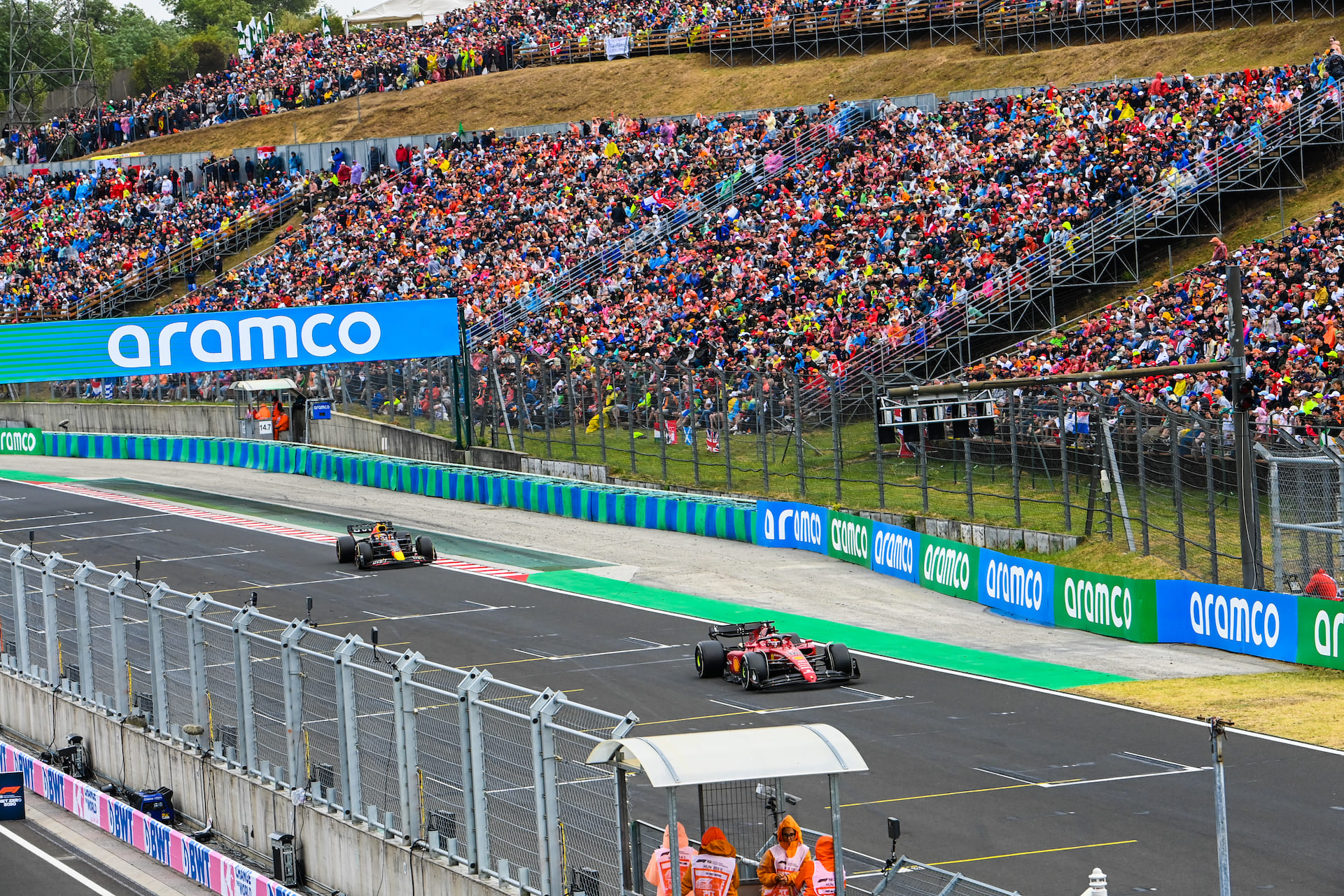
However, the greatest challenge posed by the Hungaroring is not its twisty nature alone, but the extreme thermal demands it places on the cars, particularly the tyres. The circuit is often dusty at the start of the weekend due to its infrequent use, and the track surface itself is abrasive, evolving significantly as rubber is laid down. This environment creates a perfect storm for tyre overheating. The constant cornering puts enormous and continuous energy into the tyre carcasses, generating immense heat. Unlike at other circuits, the short straights offer virtually no respite, preventing the tyres from cooling down through airflow. This problem is severely compounded by the typically scorching Hungarian summer weather, with high ambient and track temperatures adding external energy into an already stressed system.
This creates a vicious cycle: as the tyres overheat, their rubber compounds exceed their optimal working range, leading to a loss of grip. This causes the car to slide more, which in turn generates even more friction and heat, accelerating a process known as thermal degradation. Consequently, managing tyre temperatures becomes the single most critical factor for success in the race, often more so than managing traditional tyre wear. A car that is aerodynamically perfect but lacks the cooling efficiency to keep its tyres, brakes, and power unit within their operating windows will inevitably falter over a 70-lap race distance.
Pit lane and technical features
The strategic landscape of the Hungarian Grand Prix is heavily influenced by the significant time penalty associated with a pit stop. A trip through the pit lane costs a driver approximately 20.6 seconds, a substantial loss that makes track position incredibly valuable and difficult to recover on a circuit where overtaking is notoriously challenging. This high penalty elevates the importance of pit strategy, turning the race into a high-stakes chess match between the team strategists on the pit wall.
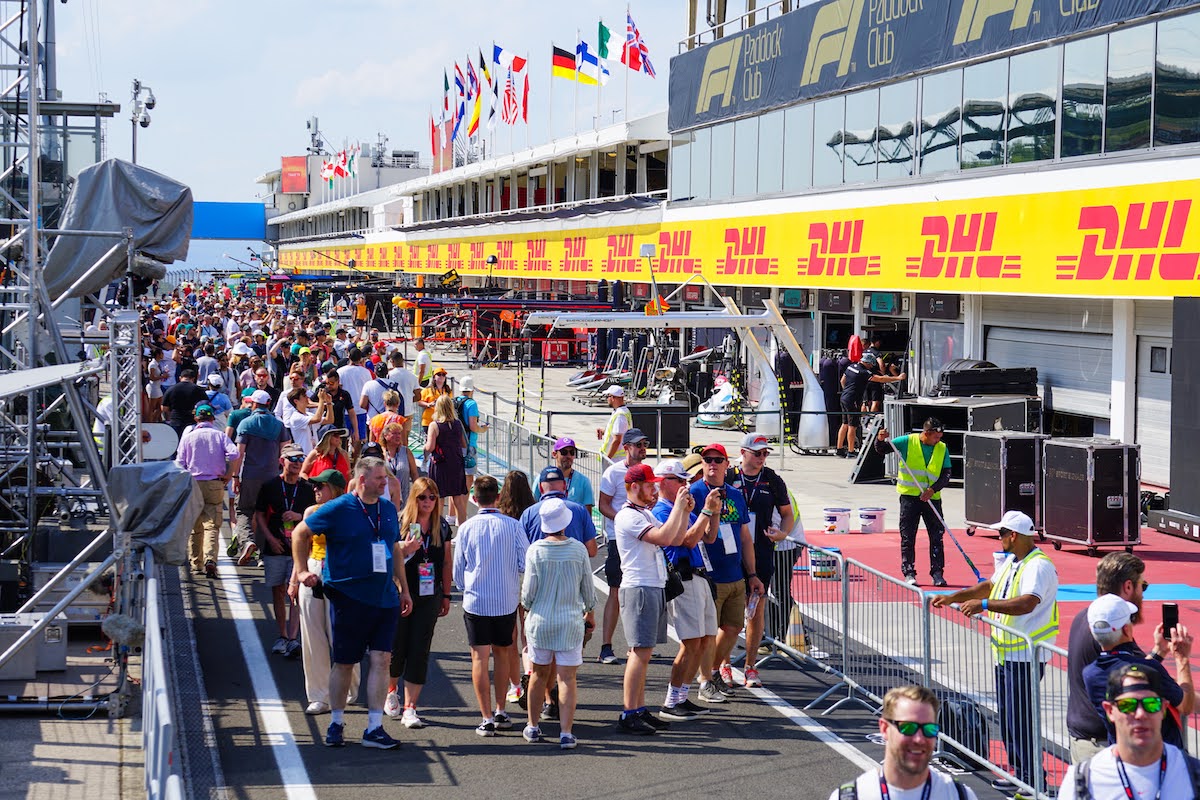
Given the difficulty of on-track passing, the undercut---pitting a lap or two earlier than a rival to take advantage of fresh tyres---is an exceptionally powerful tool at the Hungaroring. A successful undercut can be race-defining, as famously demonstrated by Michael Schumacher's Ferrari team in 1998, when a mid-race switch to a three-stop strategy allowed him to leapfrog his rivals and build a winning margin. However, it is a high-risk maneuver; a failed undercut can leave a driver emerging from the pits into traffic, completely ruining their race. This delicate balance of risk and reward is a central theme of strategy in Hungary.
Beyond strategy, the circuit imposes immense mechanical strain on the cars. The relentless sequence of corners means drivers are constantly working the gearbox, with data suggesting around 78 gear changes per lap. This, combined with the continuous cycles of acceleration and braking, places the gearbox and power unit under enormous stress, all while operating in the extreme heat of the Hungarian summer. As a result, teams are forced to run their cars in a maximum cooling configuration, opening up bodywork to improve airflow to the power unit and brakes. This setup, while necessary for reliability, often comes at the cost of a small but measurable reduction in aerodynamic efficiency, another of the critical trade-offs that teams must balance at this unique venue.
Key corners
A lap of the Hungaroring is a relentless test of a driver's precision and a car's balance. With 14 corners packed into its 4.381 km length, each turn flows into the next, demanding a perfect rhythm and punishing the slightest of errors.
- Turn 1 -- Hairpin Right: This is the most critical corner on the circuit and the single best overtaking opportunity. At the end of the long main straight, cars approach at speeds of up to 317 km/h before slamming on the brakes and decelerating to around 95 km/h in just 2.7 seconds over a distance of approximately 120-122 meters. Drivers endure a peak deceleration of 4.8g while applying a force of around 151-160 kg to the brake pedal. It is a tight, third-gear hairpin with an average speed of just under 120 km/h. A late braking point is essential for an overtake, but a clean exit is just as vital to defend down the short straight towards Turn 2. Being too aggressive on the inside kerb can unsettle the car and compromise the exit.
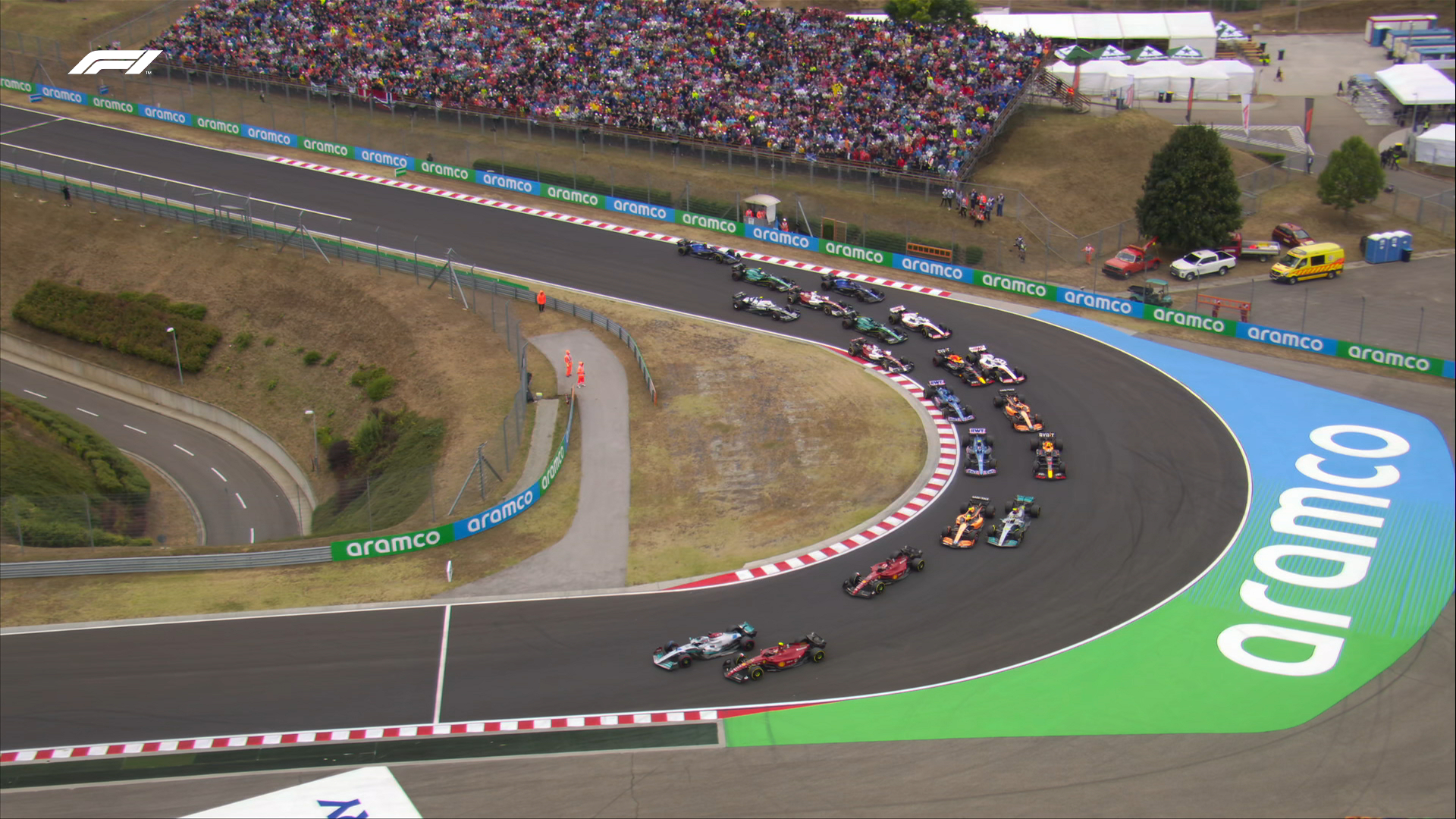
-
Turns 2 & 3 -- Downhill Left, Fast Right: Immediately after the hairpin, the track drops away downhill into the tricky, off-camber Turn 2. This second-gear corner, taken at an average speed of ~146 km/h, is challenging as the elevation change can lighten the car and induce instability under braking. A driver must trail-brake perfectly to maintain control before immediately transitioning into the fast, right-hand kink of Turn 3. Turn 3 is taken flat-out in a modern F1 car, with an average speed of over 230 km/h, and a smooth line is crucial to carry maximum momentum onto the following straight.
-
Turn 4 -- High-Speed Left: This is the fastest and one of the most daunting corners on the circuit. It's a blind-on-entry, high-speed left-hander that demands immense commitment. Cars approach at full speed, with drivers applying a small dab on the brakes before throwing the car into the apex. It is taken in sixth gear with a minimum speed of 255 km/h and an average speed across the corner of over 251 km/h. Cutting the inside kerb is necessary for the fastest line, but the large sausage kerb beyond it is a significant hazard that will throw the car off-line if struck.

-
Turns 6 & 7 -- The Chicane: This slow, technical right-left chicane represents a sharp break in the circuit's flow and is one of the most difficult sections to master. Drivers brake hard for the fourth-gear entry into Turn 6, with speeds dropping to around 135 km/h. The key to this section is aggressively using the high inside kerbs to straighten the car's path as much as possible. However, hitting the unforgiving sausage kerbs too hard will launch the car and completely ruin the line for the exit of Turn 7. A "slow in, fast out" approach is often rewarded, as a mistake in Turn 6 compromises the entire sequence.
-
Turn 11 -- Fast Left: After a sequence of medium-speed corners, the track sweeps into the formidable Turn 11. This is a long, incredibly fast left-hander that is taken flat-out in sixth gear at over 250 km/h. It is the second-fastest corner on the track, with an average speed just shy of 250 km/h, and requires a car with exceptional aerodynamic downforce and stability. Drivers take a small amount of the inside kerb to shorten the line before allowing the car to run wide to the edge of the track on exit, carrying as much speed as possible towards the braking zone for Turn 12.

- Turns 13 & 14 -- The Final Corners: This final complex is arguably the most important for overall lap time. It consists of a long, 180-degree double-apex right-hander that leads back onto the 908-meter main straight. Turn 13 is a slow, third-gear corner with a minimum speed of just 115 km/h, where drivers must be patient on the throttle to avoid washing out wide. The line through here dictates the entry into the faster Turn 14. A perfect exit from Turn 14 is critical, as any speed lost here will be magnified all the way down the straight, leaving a driver vulnerable to an overtake into Turn 1. Many drivers adopt a "V-shape" line, taking a later apex in Turn 14 to straighten the car for the exit, allowing them to get on the power earlier and maximize traction.
Racing considerations
The Hungarian Grand Prix is defined by a central paradox: while it can produce thrilling and memorable races, on-track overtaking is exceptionally difficult. The combination of a narrow racing line, the constant sequence of medium-speed corners generating turbulent "dirty air," and the lack of heavy braking zones makes it one of the hardest tracks on the calendar to make a pass. This reality places an immense premium on qualifying performance; starting at the front of the grid is more critical here than at almost any other circuit.
A phenomenon that often characterizes the race is the "DRS train." Because the main overtaking zone is a single long straight, if a group of cars are running closely together, each car behind the leader is able to activate its Drag Reduction System (DRS). This effectively cancels out the advantage for any single car trying to make a move, creating a stalemate where cars can follow but not pass. This was famously articulated by Max Verstappen after the 2023 race, where he complained of being "stuck in the DRS train," unable to advance despite having a faster car.
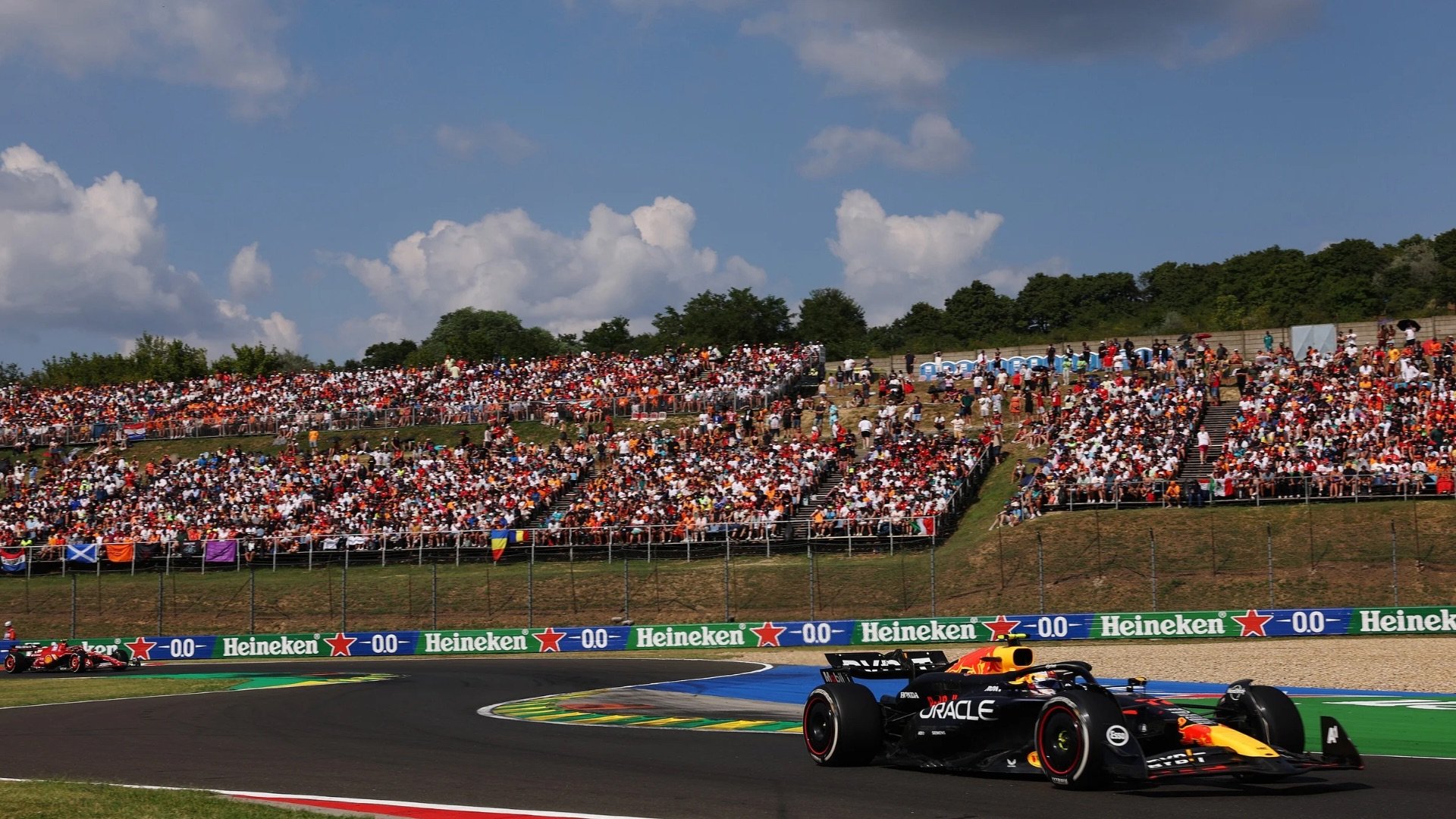
Adding another layer to the strategic complexity is the relatively low probability of a race interruption. Based on data from the last eight races, the chance of a full Safety Car deployment is just 25%, with the probability of a Virtual Safety Car also at 25%. This low likelihood of a caution period has profound implications for race strategy. At many circuits, a timely Safety Car can act as a "get out of jail free" card, offering a cheap pit stop that can erase a strategic error or bring a driver back into contention. At the Hungaroring, strategists cannot rely on such a lucky break. The infrequency of Safety Cars means that the strategic decisions made on the pit wall---particularly regarding tyre choice and the timing of pit stops---are often final and their consequences are unfiltered. A poorly timed stop or the wrong tyre compound choice cannot be undone by a fortuitous caution period. This transforms the race into a pure and unforgiving test of a team's strategic intelligence, where every decision carries immense weight and the pressure to execute flawlessly is at its peak. While major incidents can and do happen, as seen in the chaotic, multi-car pile-up at the start of the 2021 race, they are the exception rather than the rule that strategists can plan for.
Overtaking opportunities
While the Hungaroring is renowned for being a difficult place to overtake, it is not impossible. The circuit design, however, channels the vast majority of on-track action into one specific area, aided by two distinct DRS zones that share a single detection point. This detection point is located just before the entry to the final corner, Turn 14.
The two DRS zones are:
-
The main start-finish straight, which at 908 meters is the longest flat-out section of the track. Activation is 40 meters after the exit of Turn 14.
-
A much shorter zone on the straight between Turn 1 and Turn 2. Activation is just 6 meters after the apex of Turn 1.
The primary, and by far the most effective, overtaking zone is the heavy braking area for Turn 1. A successful pass here is the culmination of a perfect exit from the final corner, followed by the combined effect of the slipstream and DRS down the entire length of the main straight. The speed differential can be significant, allowing an attacking driver to draw alongside and make a move under braking into the tight hairpin.
The secondary DRS zone into Turn 2 is less of an independent overtaking spot and more of a tool to continue a battle that began in Turn 1. If a driver defends an attack into the first corner, the attacker can immediately re-deploy DRS to maintain pressure and potentially set up a move into the downhill Turn 2 braking zone, although this is a much riskier and less frequent occurrence.
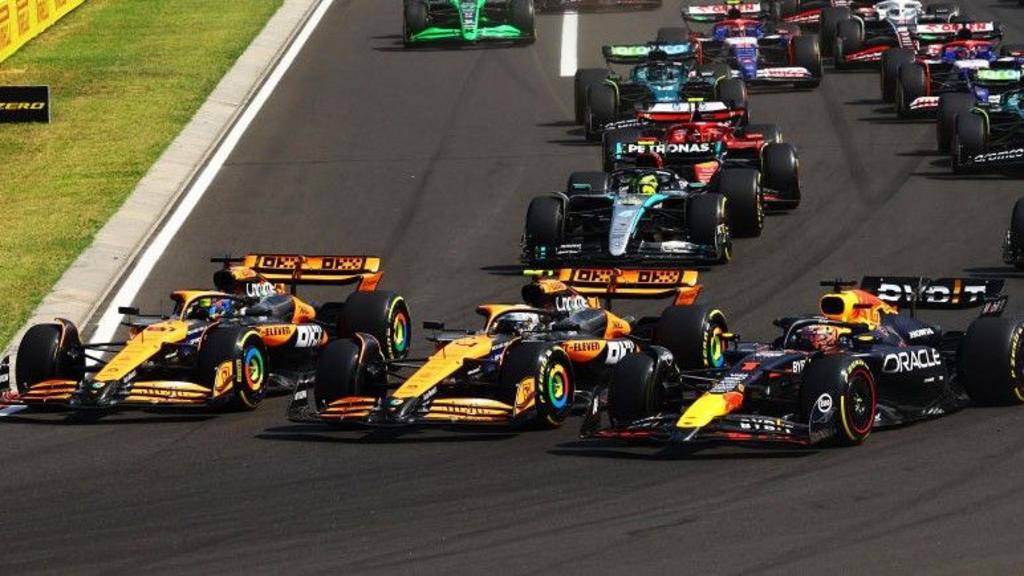
Despite the track's reputation, the 2024 Hungarian Grand Prix saw a total of 65 recorded overtakes. This figure, however, can be misleading. These are not typically straightforward "push-to-pass" maneuvers seen at other circuits. An overtake at the Hungaroring is more often the final move in a strategic battle fought over several laps. It is usually predicated on a significant difference in tyre life between two cars, often created by an undercut strategy. An attacking driver on fresher, grippier tyres has a limited window of opportunity to close the gap and execute a pass into Turn 1 before their own tyre performance begins to fade in the intense heat. Therefore, the overtakes seen in Hungary are less about raw car performance and more about the successful execution of a superior race strategy.
Braking demands
Despite the high frequency of corners, the overall stress on the braking systems at the Hungaroring is considered moderate. Brake manufacturer Brembo rates the circuit a 3 out of 5 on its difficulty scale, placing it firmly in the middle of the calendar's tracks. Drivers are on the brakes for 10 to 11 distinct events per lap, totaling over 14 seconds of braking time. This equates to approximately 19-20% of the total lap duration, a high figure that reflects the track's stop-start nature.
However, of these numerous braking zones, only two are classified as "Hard," with four being "Medium" and four "Light". The primary challenge for the braking system is not wear and tear, but heat management. The relentless sequence of corners and the short straights provide very little airflow to cool the carbon discs and calipers between applications. This issue is exacerbated by the high ambient temperatures typical of the Hungarian summer. If temperatures get too high, the brake fluid can boil, leading to a phenomenon known as "vapour lock," where the brake pedal feels long and unresponsive. Teams must therefore run maximum brake cooling ducts, and mechanics often perform multiple brake bleeding procedures throughout the weekend to ensure the system maintains its rigidity and performance.
The two most significant braking events are:
-
Turn 1 (Hairpin): This is the most demanding braking zone on the circuit. Cars decelerate from over 310 km/h down to 95 km/h in just 2.65 seconds, covering 122 meters. Drivers experience a peak deceleration of 4.8g and must apply a pedal load of up to 160 kg.
-
Turn 12 (Medium Left): While not as severe as Turn 1, this is another significant braking event where cars slow from high speed for the medium-speed left-hander, placing considerable energy into the brakes before the final sequence of corners.
The table below provides a quantitative look at the most demanding braking zones.
F1 brake data -- Hungarian GP 2025
| Turn (Name) | Initial Speed (km/h) | Final Speed (km/h) | Distance (m) | Braking Time (s) | Peak Decel (g) | Peak Pedal Load (kg) |
|---|---|---|---|---|---|---|
| T1 -- Hairpin | ~310 | ~95 | ~122 | ~2.65 | ~4.8 | ~160 |
| T12 -- Medium Left | ~280 | ~130 | ~90 | ~2.0 | ~4.0 | ~140 |
(Values are approximate, based on Brembo data)
Last year's strategic picture (2024)
The 2024 Hungarian Grand Prix served as a perfect encapsulation of the circuit's unique challenges and provided a dramatic narrative centered on strategy, on-track action, and controversial team management. The weekend began with a statement of intent from McLaren, who secured a dominant front-row lockout in qualifying, their first since 2012, with Lando Norris claiming pole position ahead of teammate Oscar Piastri.
From the moment the lights went out, the race was a story of two halves for the McLaren drivers. Piastri made a superior start to snatch the lead from Norris into Turn 1. Behind them, championship leader Max Verstappen also got the jump on Norris, but ran off track to do so and was instructed to hand the position back to avoid a penalty, leaving the two McLarens to establish control at the front. As the race unfolded, Verstappen's challenge faded, with the Red Bull driver growing increasingly frustrated with his car's handling and the team's strategy calls, eventually finding himself in a scrap for the final podium position with Lewis Hamilton and Charles Leclerc.
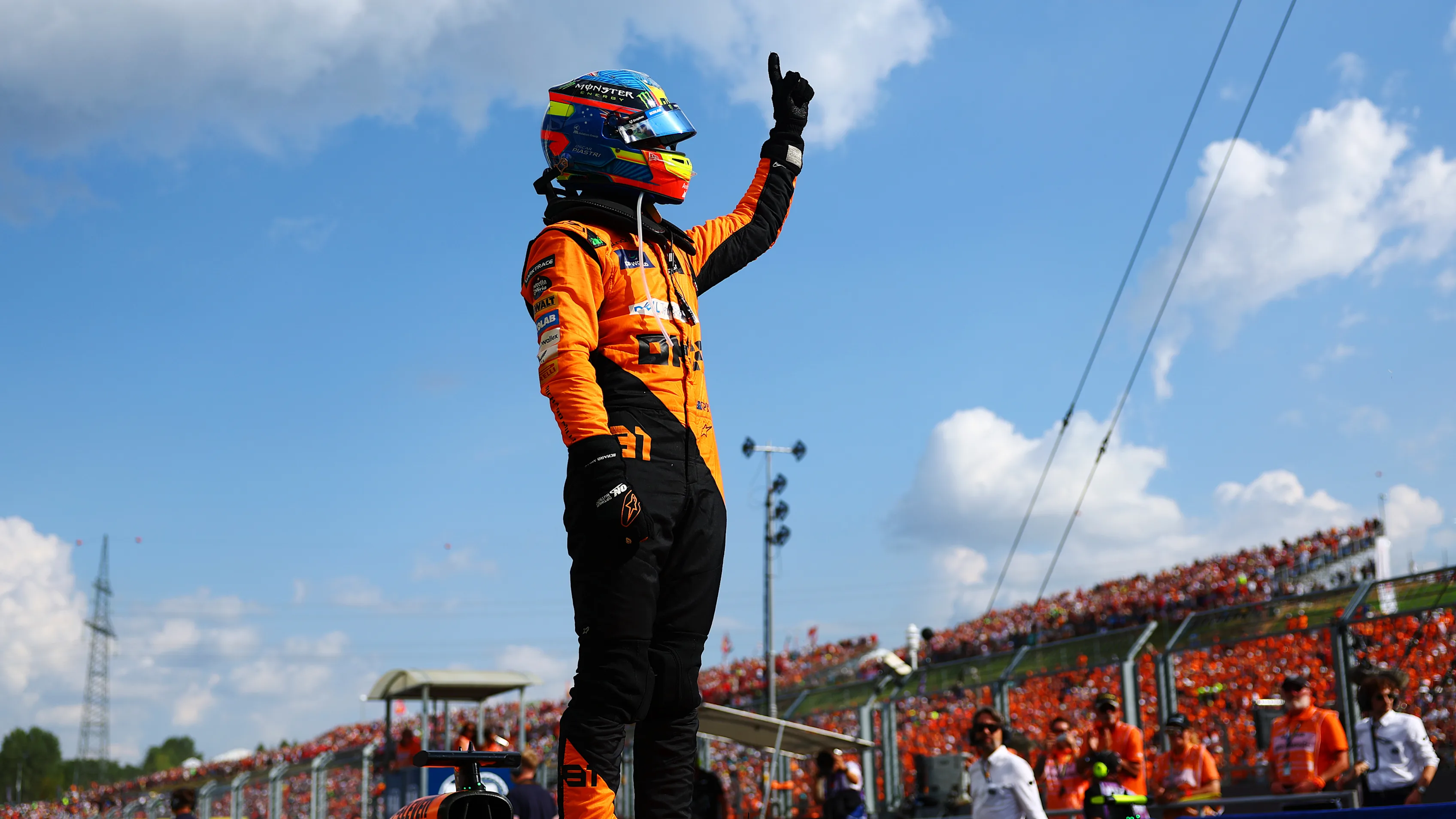
The defining moment of the race, however, came in the final stages. Through a combination of strategy and pace, Norris had managed to undercut his teammate during the pit stop cycles and build a comfortable lead. In a highly contentious move, the McLaren pit wall repeatedly instructed Norris to slow down and swap positions with Piastri. After a tense period, Norris complied on lap 68, allowing Piastri to sweep past on the main straight and claim his maiden Formula 1 victory. The result marked McLaren's first 1-2 finish since the 2021 Italian Grand Prix, but it was overshadowed by the debate surrounding the team orders.
The strategic takeaway from 2024 was clear: the Hungarian Grand Prix is won and lost through a combination of a perfect start, flawless pit strategy, and decisive team management. The race proved that even with the fastest car, raw pace is not enough to guarantee victory at the Hungaroring; execution is everything.
Weather outlook and its impact
The Hungarian Grand Prix is held in the height of the Central European summer, and the weather is typically a significant, if predictable, factor. Long-range historical data for Budapest in early August points towards a hot and dry race weekend. Maximum daytime temperatures are expected to be around 27°C (81°F), with high levels of UV radiation and relatively low humidity.
This intense heat has a direct and profound impact on every aspect of performance:
-
Tyre Management: Hot track surfaces, which can soar well above air temperature, will dramatically amplify the challenge of thermal degradation. The primary task for every driver will be to manage the surface temperature of their tyres to prevent them from overheating, blistering, and falling off the performance cliff.
-
Car Cooling: The combination of high ambient temperatures and the circuit's lack of long straights for airflow means that car cooling will be at an absolute premium. All teams will be forced to run their maximum cooling packages, opening up engine covers and brake ducts to dissipate as much heat as possible. This is critical for the reliability of the power unit, gearbox, and brakes, but it comes with a slight aerodynamic performance penalty.
-
Driver Fatigue: The Hungaroring is one of the most physically demanding races on the calendar. The relentless sequence of corners offers no rest, and when combined with the oppressive cockpit heat, it becomes a severe test of driver fitness and concentration over 70 laps.
While the forecast is for dry conditions, the possibility of a summer thunderstorm can never be completely discounted. The circuit has a history of being predominantly dry---the first wet Grand Prix was not held until 2006, twenty years after its debut. However, when rain does arrive, it invariably produces chaos and drama. A sudden downpour would completely invert the strategic landscape, transforming a predictable tyre-management race into an unpredictable lottery. The dramatic 2021 Grand Prix, which featured a wet start, a multi-car pile-up, and a shock victory for Esteban Ocon, serves as a stark reminder of how quickly conditions can change and upend the established order.
Historical records and statistics
-
First Championship Race: 1986
-
Circuit Length: 4.381 km (2.722 miles)
-
Race Laps: 70
-
Lap Record: 1:16.627 by Lewis Hamilton (Mercedes, 2020)
-
Most Driver Wins: Lewis Hamilton (8)
-
Most Pole Positions: Lewis Hamilton (9)
-
Most Constructor Wins: McLaren (12)
-
Safety Car Probability: 25% (based on the last eight races)
-
Pit Lane Time Loss: ~20.6 seconds
-
Record Attendance: 310,000 (2024)
-
Maiden Victory Hotspot: The Hungaroring has a remarkable tradition of crowning first-time Grand Prix winners. This prestigious list includes Damon Hill (1993), Fernando Alonso (2003), Jenson Button (2006), Heikki Kovalainen (2008), Esteban Ocon (2021), and most recently, Oscar Piastri (2024).
The circuit's tendency to produce maiden victories is not a coincidence but a direct consequence of its unique characteristics. The tight and twisty layout tends to neutralize pure power unit advantages, placing a greater emphasis on driver skill, chassis balance, and aerodynamic grip. This allows cars from the midfield to be more competitive than they would be at power-sensitive tracks. Furthermore, the extreme difficulty of on-track overtaking means that if a driver can seize the lead---whether through a brilliant start, a clever strategy, or chaotic conditions as Ocon did in 2021---they have a significantly higher chance of defending that position for the remainder of the race. This combination of factors creates the perfect environment for surprise results, allowing talented drivers in less-than-dominant machinery to capitalize on rare opportunities for victory.
Track characteristics (summary)
-
Length: 4.381 km
-
Corners: 14 (8 right, 6 left)
-
Full Throttle: ~55% of lap
-
Downforce Level: Maximum
-
Tyre Stress: High (Primarily Thermal)
-
Braking Stress: Medium (3/5 Difficulty)
-
Braking Events: 10 per lap
-
Top Speed: ~315 km/h
-
DRS Zones: 2
-
Overtaking Difficulty: High
-
Pit Time Loss: ~20.6 seconds
-
Safety Car Likelihood: Low (25%)
Looking ahead
The 2025 Hungarian Grand Prix is poised to be a quintessential battle of modern Formula 1, a contest fought on multiple, interconnected fronts. It begins in the design offices, with engineers striving to perfect the ultimate high-downforce aerodynamic package. It continues on the pit wall, where strategists will wage a war of data and intuition to devise the optimal, heat-resistant tyre strategy. And it culminates in the cockpit, where for 70 laps, drivers will face an unrelenting test of precision, patience, and physical endurance under the scorching August sun.
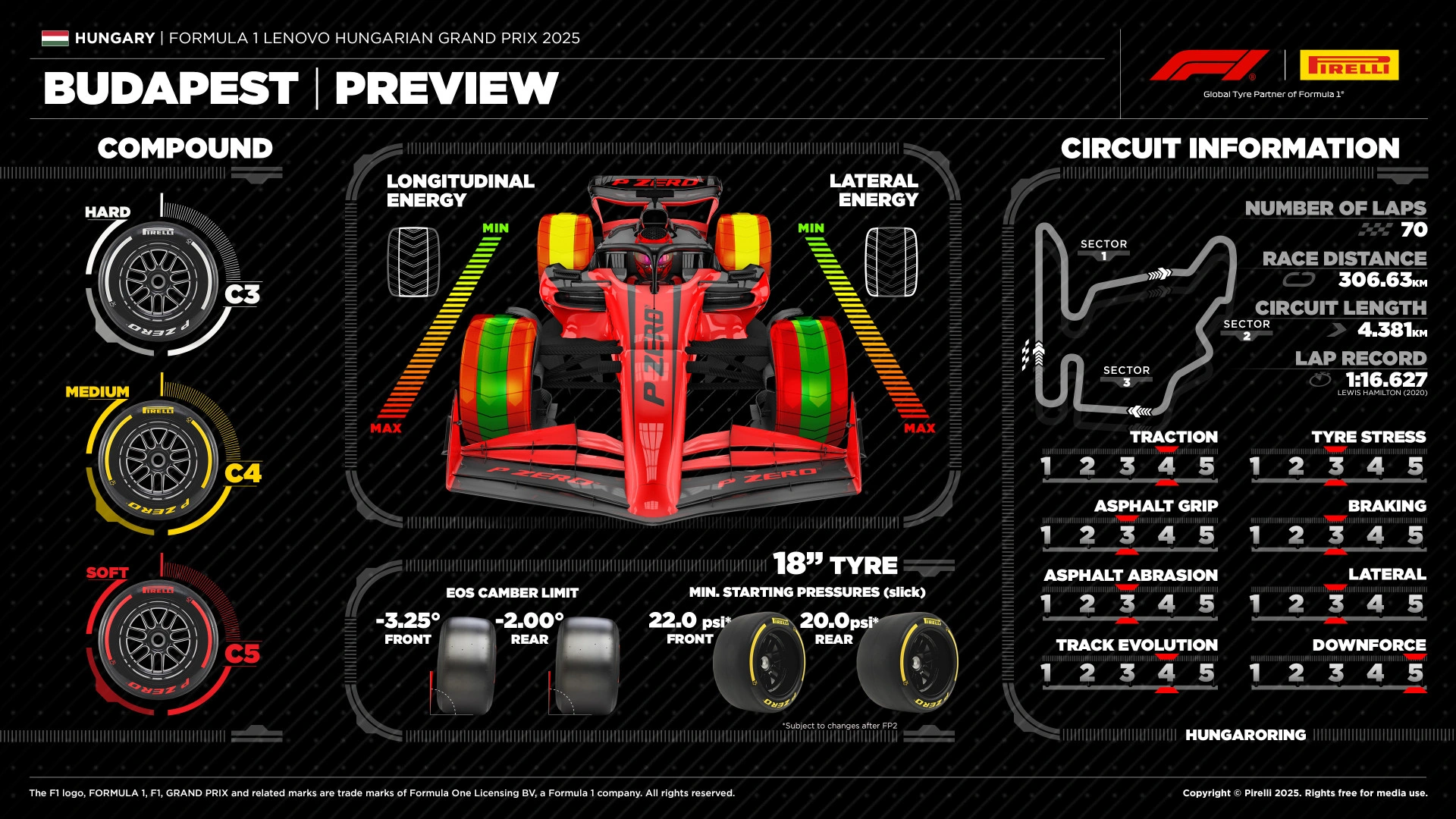
As the weekend unfolds, several key factors will be critical to watch:
-
Tyre Management: In the expected high temperatures, the ability to manage thermal degradation will be paramount. The team and driver pairing that can keep their tyres in the optimal temperature window for the longest will hold a decisive advantage.
-
Qualifying vs. Race Pace: With pole position being so important yet having only led to a win in 6 of the last 20 races, the tension between a perfect qualifying lap and a sustainable race strategy will be at its peak. Can the pole-sitter convert, or will a strategic gamble from further down the grid once again prevail?
-
The McLaren Dynamic: Following the controversial team orders of 2024, all eyes will be on the McLaren pit wall. Should their drivers find themselves in a similar 1-2 position, their management of the situation will be under intense scrutiny.
-
The New Era Hungaroring: The significant investment in a new paddock and main grandstand marks a new chapter for the historic venue. How these upgrades enhance the experience for the teams and the record-breaking crowds will be a key storyline.
While the Hungaroring may lack the raw, top-speed spectacle of circuits like Spa or Monza, it offers a challenge that is arguably more intricate and revealing. It is a pure, unfiltered examination of Formula 1's most fundamental disciplines. Victory here is not simply earned through horsepower; it is meticulously constructed through engineering ingenuity, strategic brilliance, and flawless execution. This makes the Hungarian Grand Prix a true connoisseur's race and an unmissable highlight of the 2025 season.
Sources: Official F1 and team releases, Formula1.com circuit guides, Pirelli previews, Brembo technical briefings, and race reports (2020--2024). All statistics are drawn from these sources and the F1 archives.
